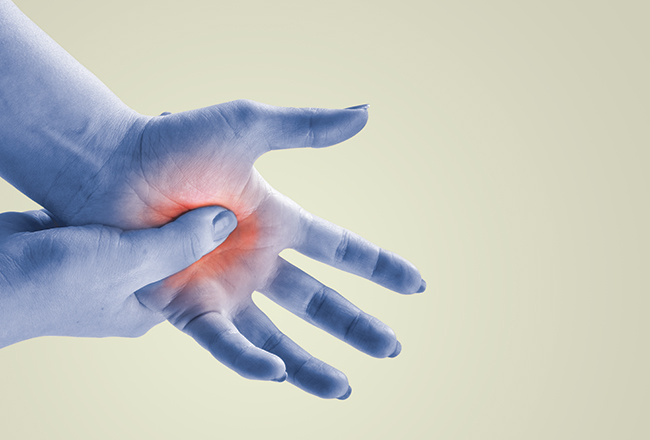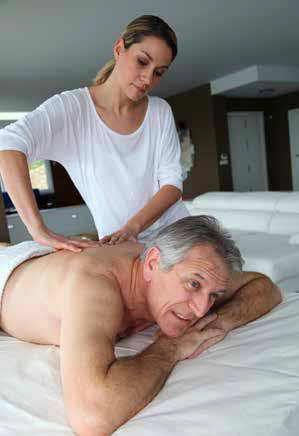Pain management has been relegated to those who prescribe and administer medications. With need to minimise the use of opioids and interest in use of non pharmacological methods to provide comfort, pain management has become part of the patient experience. The good news is that there are many ways to positively engage patients to manage their pain.
From the earliest beliefs in death being divine, to the use of prayer and rituals to ward off evil spirits, to the beginnings of science and medicine being codified by research, scientific discovery, and, now, to evidence-based practice, pain remains difficult to comprehend and manage.
For hundreds of years, the medical community believed 17th Century French philosopher Rene Descartes’ theory that the mind had no influence on the body. In1967, the breakthrough work of Ronald Melzack and Patrick Wall finally opened the door to pain management being multi-disciplinary.

That the mind could and does influence the experience of pain has created a plethora of studies that look at all aspects of the human experience. And despite this, pain management has yet to be implemented successfully in the United States and other countries around the world. For years, patients were under-treated and pain was underreported. Then, in 1990, The Joint Commission shifted its regulations, calling for pain to be the fifth vital sign, that every patient be assessed for pain and provide a self-report. Since then, the epidemic in the use of opioids prescribed by physicians for patients in and out of the hospital has become an epidmic.
So now the focus is on non-opioid pain treatment. This might include other drugs and non-pharmacologic pain management strategies such as acupuncture, massage therapy, relaxation therapy, etc. But the physical environment also informs patients’ experience of pain. And there are many ways that the micro-environment of patients can be effectively manipulated as part of pain management strategies. For some perspective on this concept, let’s begin with Florence Nightingale.
In the mid 19th Century when Florence Nightingale began observing the poor, the disabled, and the sick in the streets of London, she questioned the way the whole British healthcare system operated.
At that time European hospitals were either run by the local government or the Church. The system was paternalistic, with patients and families seeking and following the advice of physicians in all aspects of care or following religious leaders, holy men who claimed to know what to do.
Nightingale found that the comfort of the patient to be ignored by the system that was supposedly dedicated to the relief of suffering. She considered the standard circumstances in which the ill were to recover, untenable. She wrote, “the thing which strikes the experienced observer most forcibly is this, that the symptoms or the sufferings generally considered to be inevitable and incident to the disease are very often not symptoms of the disease at all, but of something quite different–of the want of fresh air, or of light, or of warmth, or of quiet, or of cleanliness, or of punctuality and care in the administration of diet, of each or of all of these.” (Nightingale, 1860)
She also wrote once that “when you have done away with all that pain and suffering, which in patients are the symptoms not of their disease, … we shall then know what are the symptoms of and the sufferings inseparable from the disease.”
The patient environment for Nightingale was primary care. It is where they spent all the many hours without having access to the distractions and activities of daily life. Physicians had already adopted a mechanistic view of medicine, and while they diagnosed and performed surgeries, they knew little about the subjective lived experience of the patient and left the suffering to be handled by the nurses. That is actually true to this day.
For Nightingale, changing linens, ensuring ample sunlight, tending to cleanliness, and providing fresh air, beauty and comfort were restorative. These were also steps to avoid infection, which was almost always fatal. Those were her toolbox. And, her theory, while at that time as yet untested in London, was fully and successfully implemented in the Scutari Military Hospital, resulting in a drop in the mortality rates from 42 per cent to two per cent within six months.
The being-ness of a patient has always been about illness, regardless of where the patient is. And, the primary complaint, concern, fear, and anxiety, was and remains about pain. But, 'pain' remains complex and ambiguous in what it means.
Theoretically, Melzack and Wall’s Gate Control theory of pain has endured correction, but has not been proved wrong. The Specificity Theory, which said that each pain has its own specific trigger and response, has been proven wrong. (Massieh Moayedi, 2013)
Opium was the original drug of choice for pain relief, offering not only freedom from physical pain, but also a kind of euphoria that created the first dependency (Brownstein, 1993). Opium, however, creates an addiction that is detrimental to patient health and has extensive social and economic implications.
Since the development of pharmaceutical analgesics, patients have become increasingly dependent on their physicians to prescribe pain medications, direct their dosage, and keep them protected from undue suffering. In the US, the co-dependence between patient and clinician regarding pain has been and remains unhealthy, if only because patients require a physician to diagnose and prescribe and physicians need to be paid, which does not happen without a diagnosis.
When the Joint Commission declared pain as the fifth vital sign in 1990, all healthcare organisations were compelled to assess and document the patient’s pain through a universal instrument for self-report. Further, the patient satisfaction surveys developed by the US government asked patients whether the clinical staff did ‘everything possible’ to control their pain. The responses were included in the final tabulation on which reimbursement was based.
The subsequent increased pressure on clinicians, the ongoing marketing of pain medications which set patients up to expect zero pain, and the deceit of US pharmaceutical companies who hid the known addictive risks of their products, have together brought patients to the point of having little understanding of their own role in managing their pain. All of which has led to the current Opioid Epidemic in America.
Other than pharmaceutical, pain management tools currently recommended for use in the US involve acupuncture, massage, and other physical interventions. However, the ways of the mind and body extend beyond their own immediacy. It is the process of meaningmaking and of spontaneous involuntary responses to environmental stimuli that informs the effectiveness of these interventions.
The environmental interface between human beings and their surroundings are the five senses, plus cognitive skills that make sense of what is happening. There are voluntary responses, which occur following a perception and define what is happening. However, the involuntary responses, such as the startle-reflex reaction to a loud noise, closing one’s eyes in the face of bright lights, and anxiety in response to crowding, are well documented and become patients’ experiences of where they are.

Environmental stressors, then, are defined by both voluntary and involuntary responses to sensory stimuli. Stressors do not adapt to the capacities or acuity of the individual, but confront patients on an ongoing basis. Thus, if the individual is unable to compensate or otherwise accommodate the environmental stimuli—whether noise that is too loud, lights that are too bright, or temperatures too cold or hot—stress is the automatic response.
There are studies that have reviewed environmental stressors and their impact on pain management that offer insights into what kind of flexibility is needed to provide comfort for a patient.
Walch et al. (2005) found the patients who had undergone spinal surgery that were placed in rooms with bright sunlight (more than 46 per cent) used 22 per cent less pain medication than those in dimly lit rooms. This is specific to natural sunlight, not overhead, fluorescent lights. These patients also experienced less stress and slightly less pain.
Other studies also looked at the benefits of exposure to sunlight, which provides Vitamin D to the patient. However, considering older patients, it is not uncommon for light-sensitivity and overall depressive moods and result in room with the shades closed and patients not venturing outside.
Studies have shown that distracting noises, whether loud or not, are stressful and cause patients anxiety. (Mazer, 2010) Auditory processing is compromised for older patients and even more under the effects of medication (Patricia, 2006). Therefore, sounds coming from talk television, from beyond the line of sight, and those that are irrelevant to the patient’s experience should be minimised, if not totally avoided.
Patients who are confined to a bed in a hospital room can also experience crowding by clutter that impinges upon the space available to them. Keeping the room tidy, removing meal trays and other elements whose usefulness has ceased, will expand the space.

The intrinsic attractiveness of an environment would be characterised as its pleasantness or unpleasantness as perceived by the user. And, from studies that look at the impact of positive valence on everything from waiting time to pain relief, feeling good is better than obsessing the bad. And, being positive, not optimistic in the usual sense, but positive rather than negative in the moment is decidedly better. (Finan and Garland, 2016; Andreatta, Mühlberger, et. al., 2010).
If the environment is stressful, represents negative feelings, or has no sunlight or beauty, it will make patients’ pain worse and challenge all pain management efforts.
Besides creating a pleasant environment for patients, it is also important to provide positive distractions. Nature in many forms—whether potted plants, photographs, access to the outdoors, or nature and music programming on different media platforms—has been found to effective in reducing stress and moving patients focus away from their pain.
Finlay and Anil (2016) found that music could alter the perception of time, with music perceived as happy resulting in a positive valence and shortening the perceived time spent in pain.
The use of virtual reality as a positive distraction for patients is also gaining traction in the US Recent studies at Cedars Sinai Medical Center in Los Angeles have shown that virtual reality can calm and distract patients, relieving the sensation of pain and easing the stress of being in the hospital. Researchers believe that immersive distraction may also help lower blood pressure, improve depression, reduce agitation for those with dementia, and be supportive for women enduring long labours while giving birth (Tashjian, Mosadeghi, Howard, et. al, 2017).
Roger Ulrich’s Theory of Supportive Design addresses environmental characteristics that support or facilitate coping and restoration with respect to the stress that accompanies illness and hospitalisation. By having restorative and buffering effects on stress, and by enhancing coping and other healthful resources, supportively designed healthcare environments can foster gains in numerous patient health outcomes (Ulrich, 1997). His three areas of focus address many elements identified in Melzack and Wall’s Gate Control Theory of pain. They are:
1. Foster control, including respecting the patient’s privacy according to their needs. Control in this case is in accordance to the capacity of the patient. And, in the process of recovery, it must be re-evaluated in order to continue to restore the autonomy and self-management capacities that will be required to be fully restore health.‘Control’ takes many forms. It may mean patients ask for a fresh pillow or call for help for toileting. It may mean that they may choose their own music or television programmes. It may also mean that they have the right to not listen to what they do not want to hear, such as other people’s conversations, music, or programmes. Having lighting choices also helps foster control. Patients should be able to close the blinds to avoid glare, open them to bring in sunlight. They should also be able to turn off overhead lights and turn on closer bed lamps.
2. Provide for social support, including not only the family, but also friends who are important to the patient. Pain can cause a specific kind of isolation that reduces the patient’s own coping capacity, which can increase fear, and also lead to ruminations - the repeating of fears and anxieties regardless of whether they are based in reality. Social support requires adequate space and seating arrangements. It also requires prioritising the needs of the patient over those of the family by modelling the kind of environment that will be appropriate for optimal recovery at home. Today, with digital capabilities, patients may have access to their family members through their smart phones. Also, messaging and emails are now commonly used to keep family and friends up to date. With these technologies, however, privacy must be addressed for the sake of patients and the other patients around them.
3. Provide opportunities for restoration, including exposure to nature and other positive distractions. The value of positive distractions for pain relief cannot be overestimated. For patients to only focus on themselves, their pain, and their concerns over their future, only makes it worse, and the suffering becomes unbearable. Providing access to nature is one solution, but it isn’t the only one. Artwork, virtual reality programmes, labyrinths (for those patients who are mobile) have also been found to be effective. And the same thing won’t work for every patient. It all depends on their age, preferences, capacities, and acuity.
Pain is experienced through many filters, including cultural and social norms that are different around the world. The unique nature of each patient and the culture with which he or she identifies, his or hervalues and preferences, and the history of the patient’s relationship to pain must all be considered. Given that pain is not only complex, but is also impacted by the immediacy of the circumstances of the patient, there are many tools that can be used to mitigate environmental stressors and provide relief.
The Opioid Epidemic now plaguing the United States is not limited to Western cultures. Reasons have been attributed to greater supply and a health system that has encourages ongoing medication for chronic pain. However, regardless of the reasons, the main path of addiction begins inside the healthcare system.
There are many reasons to ensure good pain management by mediating pain relief with both pharmaceutical and non-pharmaceutical methods. Education, close monitoring, and an authentic relationship between patients and their clinicians is critical. Also, providing a broad range of options for relieving pain that empowers patients in safe and healthy methods is the optimal way to ensure healthier longterm outcomes.